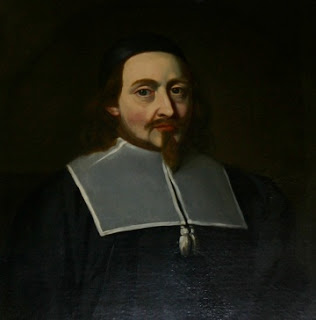John Endecott
| John Endecott | |
|---|---|
 |
|
| 1st, 10th, 13th, 15th, and 17th Governor of the Massachusetts Bay Colony | |
|
In office 1629–1630 |
|
| Succeeded by | John Winthrop |
|
In office 1644–1645 |
|
| Preceded by | John Winthrop |
| Succeeded by | John Winthrop |
|
In office 1649–1650 |
|
| Preceded by | John Winthrop |
| Succeeded by | Thomas Dudley |
|
In office 1651–1654 |
|
| Preceded by | Thomas Dudley |
| Succeeded by | Richard Bellingham |
|
In office 1655–1664 |
|
| Preceded by | Richard Bellingham |
| Succeeded by | Richard Bellingham |
| Personal details | |
| Born | unknown; before 1600 Dorchester, England |
| Died | 15 March 1664/5 (aged 77) Boston, Massachusetts Bay Colony |
| Resting place | Granary Burying Ground |
| Spouse(s) |
|
| Religion | Puritanism |
| Signature |  |
John Endecott (also spelled Endicott; before 1600 – 15 March 1664/5) was an English colonial magistrate, soldier and the first governor of the Massachusetts Bay Colony. During all of his years in the colony but one, he held some form of civil, judicial, or military high office. He served a total of 16 years as governor, including most of the last 15 years of his life; this period of service was the longest of any colonial governor. He also held important posts representing the colony as part of the New England Confederation, and was a leading force in expanding the settlement of Salem and other parts of Essex County.
Endecott was a zealous and somewhat hotheaded Puritan, with Separatist attitudes toward the Anglican Church. This sometimes put him at odds with Nonconformist views that were dominant among the colony's early leaders, which became apparent when he gave shelter to the vocally Separatist Roger Williams. Endecott also argued that women should dress modestly and that men should keep their hair short, and issued judicial decisions banishing individuals who held religious views that did not accord well with those of the Puritans. He notoriously defaced the English flag because he saw St George's Cross as a symbol of the papacy, and had four Quakers put to death for returning to the colony after their banishment. An expedition he led in 1636 is considered the opening offensive in the Pequot War, which practically destroyed the Pequot tribe as an entity.
Endecott used some of his properties to propagate fruit trees; a pear tree he planted still lives in Danvers, Massachusetts. He also engaged in one of the earliest attempts to develop a mining industry in the colonies when copper ore was found on his land. His name is found on a rock in Lake Winnipesaukee, carved by surveyors sent to identify the Massachusetts colony's northern border in 1652. Places and institutions are named for him, and (like many early colonists) he has several notable descendants.
...
Wikipedia
